

|
Follow the links to see more information about each operation |
XF1DN in IOTA operation from Angel de la Guarda NA-163 jun/2002 |
|
6J2DN (2 Months in the 70th FMRE Celebration) |
XE2K Since oct 2002 |
|
6J2K (3 Months use) |
|
|
4C2X ARRL VHF QSO PARTY operation (multi multi winner 2004) |
|
|
6I2CQ CQ 160M CONTEST 2005 |
|
|
XF4K Revillagigedo - Clarion Is. NA-115 nov/06 |
|
|
|
The Baja California Mexico Island Project
by Fred, N6AWD
In April 2002 at the Visalia DX Convention I met Hector XE2K whose call sign then was XE2DN who became interested in activating at least one of the rare islands in Baja California, many of which had not been heard from in over 10 years . Hector was introduced to me by Phil W6UC and we sat down and began to envision how seven rare island groups could be put on the air. Hector went back home to Mexicali and began rounding up some of his ham friends to put on the first of these rare islands.
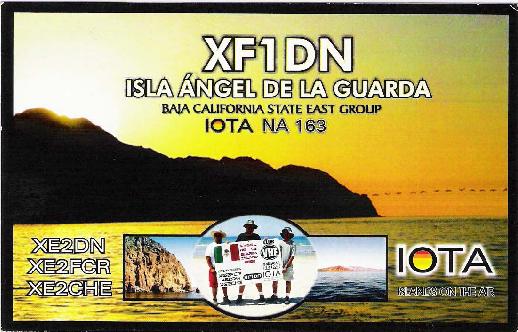
In June of 2002 XF1DN was activated by Hector along with XE2FRC and XE2CHE from the island of Angel de La Guarda and produced over 2000 contact in a little over 2 days. After this operation it became apparent that there was a lot of interest by the IOTA community judging by the number of QSL cards have been requested for NA-163. It did not take long before plans were made for another rare Mexican island activation and this came to pass in early 2003.
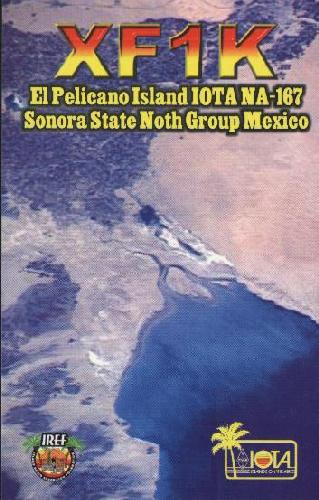
After some research Hector discovered that NA-167 is close to his home and found out at El Pelicano island falls into the state of Sonora plans were made to get it on the air. The call sign XF1K and the Permit form the environmental agency on charge of the island was issued to the group whose member now had XE2ZY along with N6VR who operated mostly CW. The goal was to set up three stations and four antennas to make 3000 contacts.
The rigs were two ICOM 706 MKIIs and a TS440S. N6VR was able to bring an all band filter box that enabled us to operate both SSB and CW on the same bands. Each of the antennas had 170 ft of coax, so we were able to separate the antenna by 300 ft to help reduce interference. For 75/80m we installed a simple inverted vee at 45ft. The SSB station had an A3 tribander at 30ft and the CW station used a Cushcraft R7 vertical at 10 feet. The fourth antenna, a GAP challenger was not erected.
On the day of the operation we met at Hector’s home, carefully packed our equipment and left for the small fishing village of El Golfo de Santa Clara about 200km away. Transportation to the island was from a small open air fishing boat measuring 7 meters by 2 meters. The trip to the island went fast, only 30 minutes. The most difficult part of the trip was the unloading and later the loading of the transport boat. We arrived on the island at sunset, but about 100 meters from the hard sand. The boat was stuck in the mud so this meant that we had to carry our equipment over this very soft tidal mud. Depending on where you stepped, each step was either ankle or knee deep in mud. It took one full hour to unload all our equipment. By the time we finished unloading the boat, the tide had retreated 200 meters, the boat could not move! The boat crew stayed the night on the island. Setup of the tents and antennas took about one hour in full dark. We were able to start on the air within 90 minutes of arriving on the island.
Over the next two days, we were able to keep two stations on the air, and sometimes three. During the first night, XE2ZY was on 80m SSB, XE2K was on 20 meter SSB and N6VR operated 20m and 40m CW. We were able to work several Europeans on 20/40m that night, but had only a short opening. >From about 0700z we were only able to work North/South America, Pacific and Asia. At sunrise, we would to move first 20m, then 17m, 15m 12m or 10m depending on propagation. Around 2100z, condx would become slow, so we would either work stateside or rest. About 2300z, we could easily run Asia on 10, 12,15, 17 & 20m.
We were very amazed how all the antennas performed in that muddy island. We managed to work several Europeans on 40 and 75m SSB with just 100 watts power! The beam was able to easily run Europe and Asia. N6VR, the CW operator did well with the R7, but did notice that the signals on the beam to Europe were 1 to 2 ‘S’ units stronger. In the end, the SSB operators made 4000 contacts and CW made 2000 contacts. We were pleased!
The weather during the operation was very cold for us. On the first morning, the temperature was 4 degree C. The operating tent was a large open screen tent that allowed the wind to easily enter. Luckily, Hector had thought of this and brought a tarp to hang over half of the tent to provide some windbreak. The next two mornings were not as cold, 6 degrees. We chose this time of year to operate because of the weather. During the summer, the temperature can easily be 45 degrees C with humidity of 95 percent!
Leaving the island was the most difficult part of the trip. The tide was very low so the boat was stuck in the mud 800m away from our site. Fortunately, the Captain brought additional help so we had to make only one trip to the boat. It still took more than one hour to get all the gear and equipment into the boat. As before, the tide had retreated and the boat stuck in the mud 100m from the water! We did not want to wait 3 more days for the tide to return so we pushed the boat across the mud to the ocean. This took almost 45 minutes.
The most unusual thing I discovered about Isla Pelicano is the mud and tides. During extreme tides, there may be only a little of the island exposed, 100m by 300m. During the low tides, while we were there, the island was perhaps 1km by 3km in size. No one lives on the island and there are no buildings or structures. Only on the highest points of the island does some short grass grow. The main activity on the island is clam digging. We crazy IOTA operators are the only other people that would want to be there.
The NA-167 activation produced over 6000 contacts in less than 3 days. Propagation was good for us.
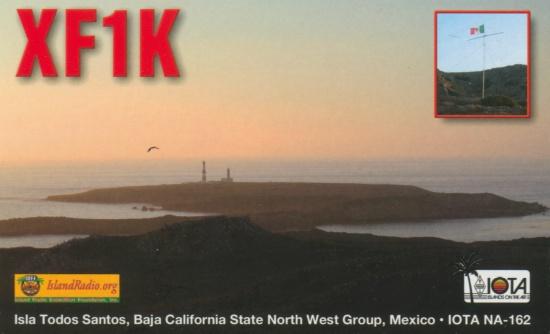
It was not long before the XF1K group was talking about the next operation and Hector selected to go to Ensenada and scout out the logistics of activating NA-162. From shore one can see two islands about 10 miles off shore named Todos Santos. This then became the next target and it was heard from in September 2003. This time the group was made up of XE2K Hector, XE2ZY, XE2ED, N6VR, N6KZ and XE1NTT / N6AN.
The Todos Santos islands are made of two islands (Isla Norte and Isla Sur) about 20 km (12 miles) west of Ensenada, which is about 80 miles south of the US-Mexico border.
The highest elevation is approximately 200 meters. Isla Norte is mostly flat, with a radio tower and two lighthouses, one active, the other inactive. Both islands are nesting grounds for brown pelicans, cormorants, blue herons, ospreys, and various other sea bird species. Both islands are rocky, barren, treeless desert islands. South Island has more hills, with few level and clear locations to set up stations.
For this operation, Hector, XE2K, requested the call sign XF1K, same callsign as his previous NA167 operation. The team would be made up of six operators, three from Mexico and three from the United States. This would be a large enough team to physically set up antennas in the difficult island terrain, operate the multiple HF/VHF/Satellite stations and to work a large number US, JA, and EU stations.
After spending the night in Ensenada, we awoke early in the morning. We drove the short distance to the quiet, dark Ensenada harbor to load our gear onto the ship Juanitos, a 32-foot charter fishing boat. It sure is surprising how much gear six hams can pack. In fact, we had to negotiate a larger boat for the gear, and us doubling the cost of the transportation to and from the Island. With the rising sun just peaking over the eastern Mexican Mountains, we slowly sailed out of the harbor into gently rolling seas, on to the Todos Santos Islands.
After a trip of about 1 hour we arrived at Isla Sur (Southern Island) at a commercial fish camp (ranch house). This would be our home and operating area for the next four days. Hector, XE2K had previously contacted the owner-operators of this camp, explaining our purpose and requested access to stay in their main camp. Permission was granted so we actually had beds to sleep in and a kitchen to use. Upon arrival we unloaded the Juanitos and moved our large amount of equipment, food and fresh water up the 75-foot ramp to the fish camp’s main area. The WX was warm, about 30 degrees C, humidity about 90 percent, so we were totally soaked and exhausted after that.
We next had to carry about half the gear up another 150m dirt path at 50m height to set up the primary location in order to have a better path to JA and Oceania which were blocked at the ranch house location. We had a clear ocean path east for NA and EU! The second operating position was set-up at the ranch house, with the GAP vertical just a few meters above the ocean with a clear shot from north, east to south.
The upper stations were established on a 50-meter high ridge above the ranch house in a large tent. This station had two HF stations, the satellite station, and the VHF (6 meter) station. Antennas were two, three-element yagis (HyGainTH-3 and Cushcraft A-3), mounted upon 30- and 25-foot vertical masts, respectively. The satellite antennas (AO-40) were mounted upon a short roof tower, ground mounted. A Cushcraft R-7 vertical mast-mounted on the edge of the sea cliff, 30m above the ocean. A 40-foot mast with inverted vee dipoles for 40 and 80 meters completed the upper station. Power was provided by four 12 VDC batteries charged with an 1800 watt portable generator.
By Saturday evening, our last night on the island, we had over 5K QSOs and decided to begin taking down our stations to be ready for the 9 am arrival of our boat on Sunday morning. Everything came down just fine (we were blessed by a wet sea fog that morning) so we loaded the equipment and ourselves onto the Juanitos for the return voyage through the quiet sea back to Ensenada. Upon landing, we unloaded our gear from the boat into our cars for the final time. We rendezvoused at Hectors nearby relative’s home to leave some of the equipment (hopefully for the next IOTA expedition). We then wished each other well and went our separate ways home to hot showers and much deserved rests.
The results of the XF1K operation were most satisfying considering the only fair band conditions. 10m and 12m never opened.15m opened to Europe and Asia for only several hours a day. We had one very good European opening on 17m with over 100 Europeans on CW. 20m of course, was our best band to all areas of the world. 30m was a pleasant surprise with 700 contacts, many in Europe and Asia. 40m was our band to Asia, 65 percent of the QSOs were with Japan. 80m produced only 60 contacts in the US Sprint contest. The VHF/UHF operator had (31) 2 & 6m contacts, and (30) AO7, AO40 & SO50 contacts. The continent and mode breakdown is as follows:
Continent QSOs Percent Mode QSOs Percent
US 3150 57% CW 3231 59%
EU 931 17% SSB 2238 41%
JA 756 14% Total 5469
Others 635 12%
Radio equipment consisted of three ICOM 706 and one Kenwood 440S. Power output was usually about 80 watts. All HF stations had RX filters so we were able to operate both CW and SSB on most bands. There was no noise so we were able to hear all most any signal that called us. When this operation was concluded the group produced over 5000 contacts.
By now most of the rare Baja islands closed to Hector’s home had been on the air so it came down to looking at what would be next from the list. The plan called for NA-164 165 and 166 along with 124 left to be considered.
In late 2003 it was decided to do NA-166 in the state of Sonora by activating Pajoros Island. The plan called for activation in early 2004.
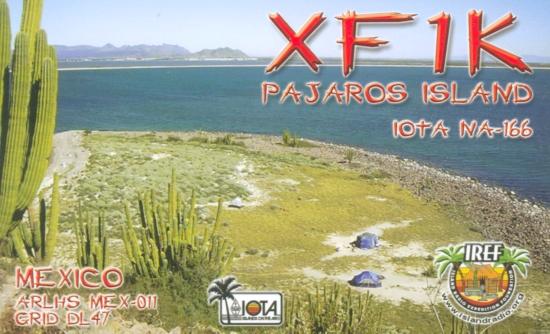
The target date to start operations from Parajos was February 5, 2004. At noon on February 3, N6VR and N6JV arrived in Mexicali, Hector’s home and after passing through customs. The combined cargo was loaded in a rental truck that was large enough for the equipment and operators. Hector had fabricated a pipe rack that would hold all the masts, yagis and verticals above the bed of the truck. With everything loaded and tied down, it was time to head further south. Guaymas, Sonora, the final destination would be 500 miles or 800 km away.
The highways of Northern Mexico are in good condition and there were no problems traveling through the State of Sonora. There were several customs and security checkpoints to pass through, but all the papers were in order. Hector was very concerned about customs and was relived when we easily made it through, for the time that will took to explain and check all the equipment. After midnight, the truck arrived in a small village near Hermosillo, Sonora. Marco, XE2TG, has a second operating and contesting location in a cottage away from the noise of the large city. Arrangements had been made to sleep there for the night. In the morning it was breakfast and then to Marco’s home in the city. Marco’s truck was loaded with additional gear and after picking up Gerardo, XE2Q, the convoy headed further south to Guaymas. A few hours later, the operators met with the local hams that would be the support team. XE2TNT, XE2UCT, XE2TVV and his son, and Sr. Miguel Orozco, who provided the boat for the trip to Parajos. By mid afternoon the boat was loaded and there was enough room for 3 passengers. Hector, Gerardo and Norm made the first trip to the island in the 18-foot outboard.
Careful loading of the boat resulted in everything getting to the island dry except for the passengers. Miguel maneuvered the boat through the shallow areas around the landing site and stopped in the sand 10 meters off shore. It was time to take off the shoes and get into the water. The water was a bit cold and the many sharp seashells made the unloading challenging. Once everything was on the beach, the boat returned for the rest of the party. Work started on the first of the beam antennas (TH3JR) that was to be installed near the beach. Once erected, it was connected to an IC706 Mk2 using a storage battery to let everyone know that XF1K was on the island. It was decided to keep on the air from the shore while the rest of the gear was moved off the beach and the tents set up. The boat had returned and there were more people to help with the tents and antennas. It was getting dark when the pile on 14260 was worked out. The wind was blowing strongly and the foot switch kept getting buried in the sand, but it was exciting to finally get on.
Parajos is a finger shaped island of volcanic origin. The volcanic rock forms a steep long hill that is covered by the large Cardon cactus. At one end of the island is the lighthouse and on the other is a 100-meter spit of level sand where the operation took place. The middle of the spit is about 1 meter above sea level. There is a small clearing in the grass there and this is where the main operating tent was placed with the sleeping tent nearby. To minimize interference, the tent that was to be used exclusively for CW was placed closer to the beach. It was also used for sleeping. The TH3JR yagi remained on the beach along with a DX88 all band vertical. These were used mainly by the CW station using an IC 706 Mk2. The A3S yagi, R7 vertical, 6-meter beam and the low band inverted “V” dipoles fed the main operating tent that had an IC 706, TS440S and a FT100 available. All rigs were used in conjunction with laptop computers for logging.
A total of six deep cycle storage batteries were available as well as two 1800-watt generators. Each station could choose whichever power source it could utilize best. Some of the computers could run on the 12-volt batteries. Power consumption was never a problem and one of the 1800-watt generators could run the entire camp. The generators consumed ten gallons of gasoline during the operation.
The weather during the operation was very good with the exception of a constant wind that threatened to blow the tents and antennas down for the first two days. Large rocks had to be placed over the tent pegs to keep them in the ground. Antenna guy points were made from long reinforcing rods that would hold in the sand. The wind made sleeping difficult and dust got into everything.
The first day netted several QSOs on 20, 40 and 75 meter SSB and 30 and 40 CW. Only a few Europeans were worked, but the pile of JAs on 40 meters lasted all night. With the dawn of the second day, good openings into Europe were worked on 20 and 15 meters. In the afternoon, the JA and North American pileups kept everyone busy. We were aware that few stations in Eastern Europe were in the log so we tried to concentrate on bands and times that would be best for that area. Conditions improved as the operation went on and by the third day, large pileups of stations from all over Europe were put into the log. Even 40 meters was a good band for working stations in Europe and the Middle East. One hundred watts is good power when people are looking for you. The initial count had 1286 European QSOs and 1318 with Japan.
The QSOs by band:
BAND SSB CW
6 17
10 372 1
12 76 219
15 951 754
17 297 398
20 679 498
30 404
40 94 1691
80 505 82
160 6
TOTALS: 2997 4047
The grand total including dupes was 7221.
With NA-166 out of the way it now was time to plan to venture into Southern Baja State some 500 south of Hector’s home. On this expedition two different IOTA group were put on, namely.
After spending the night in El Centro, California, we crossed the border about 4 am and began the long trip south. We arrived just after dawn in Ensenada. After eating breakfast at Hector's favorite truck stop, we headed south on Highway 1 towards the border of Baja California Norte and Baja California Sur. The vegetation of Baja is very special and unique. Some types of desert trees are only found there. After traveling all day, the truck arrived in the town of Guerrero Negro. A distance of 680 miles had been traveled. Guerrero Negro is the largest city in this part of Baja. This is where the Biosphere Reserve El Vizcaino, which is the agency with the responsibility for the wildlife protection in this area, and where we obtained the written approval for the trip to Asuncion Island. The detour had added several hours to the trip so it was decided to drive to Bahia Asuncion that evening and try to get on the island early in the morning. We needed the extra time to make sure we could operate two full days on Asuncion. Several hours later the truck limped into the small town of Bahia Asuncion. The last 60 km had been over dirt roads where the dirt was arranged mostly as holes, ruts and washboards. Bahia Asuncion is a town of about 800 people, so it wasn’t difficult to find the Internet Café and its owner, Jose Luis Ogawa, ex-XE2TT, who had helped us arrange transportation. We located the fisherman who would take us to the island the next morning.
Isla Asuncion - NA164
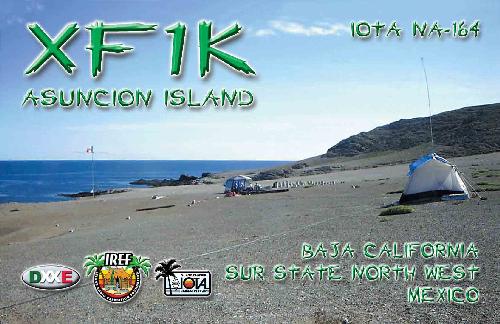
Before dawn the crew was ready and on the beach. There are no docks or launching facilities. All the boats are pulled out on the sand with a communal one-ton surplus army truck. Boats are launched by extending a pole from the truck and then shoving the boats into the water. The boat was loaded with gear and people and pushed into the bay. Isla Asuncion is about 2 miles from the town. It is a protected island and has a large population of seals and birds. At one time, there were people living there and the cement foundation of a small building is still present as well as some cement steps that have been set into the cliff. This is where we landed to the objections of several large seals that had been using the steps. The boat captain had arranged to provide us with a helper to assist us in carrying all the gear up the cliff to the campsite. We had to restrict our activities to the area where we landed so as not to disturb the wildlife. The seagulls that occupied this area were not inconvenienced by our presence and seemed to accept us. Each morning the tents would be surrounded by sea gulls that took little interest in us. The gulls would decide to all take off at once several times a day. The noise from several hundred sea gulls all squawking at once as they passed over the tent, required a short QRX until they passed.
The main tent was placed near the old foundation with the A3S tribander on one side and a 30-foot mast with a 75/40 meter inverted V dipole on the other. The DX88 vertical with thirty-five 75-foot radials was placed about 100 feet south, as far as the coax would reach. The smaller tent was placed to the north with the generators in between. A pair of R7 verticals were placed to the north of the small tent to get maximum separation from the other vertical. An IC706 was used as the SSB station and a TS450S was used for CW in the main tent. The small tent had the second CW station using an IC706 Mk2. The main tent also had the use of a 400-watt amplifier borrowed from Mike, AD5A. Various filters were employed to cut down interference. As soon as the tribander was up, we were on 20 meter SSB. The first contact was with Fred, N6AWD. The SSB station and at least one CW station were on all day and night. Shifts on 40 meter CW insured the maximum number of stations in the log. The boat made extra trips to see how we were doing and brought some fresh food prepared by Captains wife. Fish and lobster tacos seem to be popular.
The weather was very clear and warm during the day, but the wind never ceased. During the night the small tent collapsed in the wind several times on top of the operator and required a QRX to tie things down. Chunks of concrete from the demolished building helped hold down tent pegs. In spite of the wind, the propagation was very good and exceptionally quiet. We had good openings into Europe on 40 and 20 meters. Europe was also worked on 75/80. By the second morning, the last European was in the 20-meter CW log. We had made a total of 5334 QSOs. The camp was disassembled and equipment hauled down to the beach. The boat Captain was back with another helper and the boat was loaded. This time it was low tide and there was great difficulty in getting the boat back into the open water. Everyone was in the water pushing the boat with each large wave. Once into the sea, it was a very slow trip as the swell was very high. After the truck pulled the boat onto the beach and everything was loaded onto the truck, we all had a nice meal as the guests of our boat Captain and his wife at their home. The trip across Baja took the rest of the day and we arrived in Santa Rosalia, an old French mining town and port, after traveling 160 miles. We had to present our permits to the local Port authority and inform them of our plans to stay on Santa Ines Island. The next day, we traveled the additional 40 miles south to Mulege.
The QSOs by band on NA164:
|
BAND |
SSB |
CW |
|
10 |
50 |
0 |
|
12 |
35 |
1 |
|
15 |
401 |
104 |
|
17 |
443 |
176 |
|
20 |
370 |
786 |
|
30 |
0 |
586 |
|
40 |
21 |
1760 |
|
80 |
486 |
115 |
|
TOTALS |
1806 |
3528 |
Breakdown of QSOs on NA164:
|
US |
2937 |
55% |
|
JA |
758 |
14% |
|
EUR |
768 |
14% |
|
VE |
278 |
5% |
|
CENT/S. AM |
191 |
4% |
|
OTHERS |
403 |
8% |
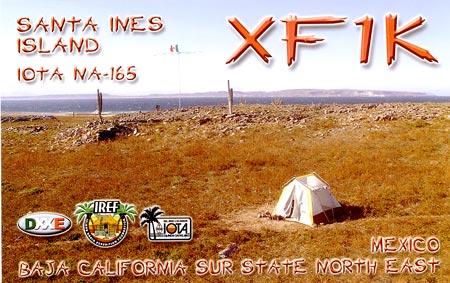
Mulege is a fishing and tourist town on the mouth of one of the few rivers in Baja. It is very tropical with many palm and fruit trees. An inspection of the sea confirmed what we had seen in Santa Rosalia. The weather was bad and it would be too dangerous to try to travel the 9 miles to the island. Arrangements with Jose Luis and Antonio Romero were made to take us to the island if weather permitted. We would stay a few days and see what happened. XE2TG, XE2Q and XE2UCT had planned on joining us for Santa Ines, but the poor weather convinced them that it wasn’t worth the risk and high expense of traveling by ferry from Guaymas in Sonora to Santa Rosalia in Baja Sur, an eight-hour trip. Success at this point was very doubtful. A local tour operator also showed us a web site where the sea swell could be predicted. There was the possibility of making it to Santa Ines the third day. All of the equipment and supplies were sorted so that only the minimum would be taken to the island. About one third of what was used before was left with the truck. All of the batteries were given a full charge in the motel room.
On the morning of the 14th of January the boat was loaded with gear and towed down to the launching area by the Mulege Lighthouse at the mouth of the river. It was smooth going until we hit the open sea. The swell was high and the boat kept dropping off one wave into the next. Life jackets were used, but only to sit on. It was a very rough trip. Once we were near the island, the sea became calmer and we had little trouble unloading everything on the beach. There are three islands in this group, but the other two were little more than small rocks. The south end of the island had a low ridge that afforded a little protection from the wind and a good place to set the beam up. As soon as the beam was up, a station was active on 20-meter SSB using battery power. Pat, VE7QCR, was the first contact. During this pile up, the main tent was built and placed over the operator. By noon, all the tents and antennas were up. Only one R7 was used on the south end of the camp and the DX88 as far north as possible. The 75-meter dipole was placed near the center by the generators. The coax for the tribander could reach either tent. The wind had followed us from the Pacific side of Baja to the Sea of Cortez side and never let up. The next day, the sea was very rough and we were getting nervous about the trip back.
The operating pattern that had worked so well at Asuncion was used on Santa Ines. Forty meters was on all night long. A good European opening on 20 meters in the morning worked well using the R7. The last morning we planned to use the tribander to make sure all the Europeans that wanted us had the best chance. During the early morning, there was a flare and 40 meters was very good long path to Europe. When 20 meters was tried, only a few Northern Europeans were heard. The sea was rough and the boat arrived early to try and get us off the island. AD5A was the last in the log for a total of 4458 QSOs. We began to tear down the camp as fast as possible. What once took us 4 hours, we did in 2. We were very tired and had to wade into the water to get lines on the boat so we could get it close enough to load. Equipment was carried out to the boat and stowed anywhere it would fit. Once the lines and anchor were secured, it was back into open water. The trip out was rough; the trip back was a twice as bad. We were wet when we got into the boat and managed to get a lot wetter. Nine miles had to be endured before we reached the river mouth at Mulege. If we and the boat’s Captain knew what we were going to be in for, we would never have gone out.
The QSOs by band on NA165:
|
BAND |
SSB |
CW |
|
10 |
7 |
21 |
|
12 |
91 |
0 |
|
15 |
316 |
114 |
|
17 |
154 |
293 |
|
20 |
459 |
558 |
|
30 |
0 |
373 |
|
40 |
9 |
1468 |
|
80 |
323 |
195 |
|
TOTALS |
1359 |
3022 |
Breakdown of QSOs on NA165:
|
US |
2264 |
53% |
|
JA |
631 |
15% |
|
EUR |
501 |
12% |
|
VE |
181 |
4% |
|
LATIN AMERICA |
159 |
4% |
|
OTHERS |
546 |
12% |
So as of early 2005 six rare Mexican island groups have been heard from thus only NA-124 remained. As I write this short history of the XF1K group NA-124 will be heard from in February 2006.
I want to thank Ray N6VR and Norm N6JV for providing their thoughts from their island adventures.
Baja California Sur – 2006
NA-124
After six successful IOTA operations off both coasts of Baja California and in the Sea of Cortez by the XF1K team, the last group in the area that was high on the needed list and that did not require special logistical arrangements was the Baja California Sur State South East group, NA-124. This group consists of Ballena, Cerralvo, Espiritu Santo, Gallina, Gallo, Partida, Reina, San Diego, San Francisco, San Jose and Santa Cruz. In order to determine the best choice for activation, Hector (XE2K) and Diana (XE2DN) and their son Alberto traveled 1600 km in their pickup truck from Hector’s home in Mexicali to La Paz, Baja Sur and arrived on January 30, 2006. The pickup had been loaded with all the antennas, generators, tents and supplies, and most of the transceivers. Fred (N6AWD) and Ray (N6VR) had hauled gear to Mexicali a few weeks before. In La Paz, Hector met with Bernardo (XE2HWB), a local resident, and studied the most suitable choices of islands and transportation. Cerralvo Island was chosen because of the available transportation and known beaches to operate from. Other islands that were close had poor landings and doubtful operating sites. Cerralvo is about 35 km long, 8 km wide and very steep hills and cliffs straight into the ocean. There are few beaches and no population except for herds of wild goats. About 50 km east of La Paz on the Sea of Cortez, is the small fishing village of El Sargento. A local fisherman was hired to haul the crew and gear across to Cerralvo Island.

Because of the long distances to La Paz, the rest of the group decided to fly in. On February 1, Norm (XE2/N6JV) and Ray (XE2/N6VR) flew from Los Angeles to Hermosillo, Sonora where they met Marco (XE2TG) and the three flew to La Paz. A reception committee was waiting at the La Paz airport. Hector had made hotel reservations for everyone for the three nights they would be in La Paz. The following day, El Sargento was visited and the shopping centers of La Paz provided the required food and extra camping equipment. The radio gear was sorted and readied for the trip the next day.
Before dawn, Hector's truck and Bernardo’s car transported everyone to El Sargento and the 5.5 m fiberglass fishing boat, loaded with gear and the 5 operators, was pushed into the water. The sea was very calm and smooth. The landing beach was near the north end of the island and was about 23 km from El Sargento. The sandy beach made it easy to unload the gear. When everything was on the beach, the A3S tribander was erected and a temporary station was set up in the sand on 20 meters SSB using battery power. K9PPY was the first in the log, SM3CXS was the first European, UA9YE the first Asian, NH6NY was first from Oceania and EA8AKN the first from Africa. South America wasn’t worked until the next day when HK3JJH made the log. Propagation had not been good, so when Europeans were heard, as many as possible were logged. There was no guarantee that conditions would hold.
The beach we landed on was about 125 m long and 25 m deep at the widest and ending at a high vertical cliff or hill. The main operating tent was placed on the northern end and the smaller tent that was the second CW position and sleeping tent to the south about 35 m. The two 1800 watt generators were in the middle near some large rocks that provided some noise protection. A DX88 vertical with several of its radials running into the ocean was placed south of the CW tent for maximum separation. To the north of the main tent, a R7 vertical, an A3WS 17/12 meter yagi and a mast for low band dipoles was placed. As there were no trees available, a handy cactus held up a wire antenna. Small cacti had to just hang on where they could. The A3S was near the generators. An IC706, a FT847 and a TS450S were used in the main tent and an IC706 Mk2 was used in the CW tent. Hector, Bernardo and Marco kept the SSB rigs busy and Ray operated one rig on CW from the main tent. The main tent had the option of using AD5A’s 400 watt amplifier if needed. Norm stayed down the beach in the smaller tent on CW using the DX88. This tent also had three air mattresses for sleeping. Computers were used for logging at all positions. At times all four rigs were on at once with one SSB and one CW rig active at all times. The high cliff behind the beach shielded South America and Africa, but operating options were limited and the site provided a good path to Europe, North America and the Pacific.
Being interested in making contacts, food was not a high priority. The morning meal was mostly dry cereal with packaged milk or breakfast bars along with hot coffee. For lunch and dinner we ate some prepared sandwiches but also heated cans of stew and beans. At all hours we were able to snack on a very large bag of beef jerky that Marco had brought from Hermosillo.
The weather was perfect with no high winds or uncomfortable temperature. High waves did threaten the DX88 on the second day, but the sea calmed by Sunday. Only a few contacts were made above 17 meters due to low sun spot activity. Big pile-ups were encountered on 17 through 75 meters with many Europeans worked. The location was especially good to Asia and many QRP stations went into the log. A total of 6068 QSOs were made including 965 in Europe.
BAND SSB CW 10 51 0 12 0 30 15 47 10 17 505 683 20 695 1019 30 0 517 40 213 1567 80 518 0 160 22 0
Continent breakdown
NORTH AMERICA 3268 QSOS 53.4% ASIA 1820 29.9% EUROPE 965 15.9% OCEANIA 21 .34% AFRICA 7 .12% SOUTH AMERICA 2
On Sunday morning we started taking down some of the antennas and the small tent. The gear was packed in waterproof plastic bags and carried to the landing area. There were still Europeans being heard on 20 meters, so one station and antenna remained on until the last. When the boat arrived on schedule, the last station and antenna were taked down and loaded for the return trip to El Sargento. This included 2 large bags full of trash. The return trip was smooth and no one got too wet landing the boat. Diana returned with the truck, and when everything was loaded, the group was invited to the QTH of Antonio (XE2HWH) and Justina in El Sargento where we were treated to a barbecue. As food preparation wasn’t a high priority on the island, vast quantities of food and drink (beer) were consumed throughout the afternoon. When we arrived at the hotel, much needed showers and shaves made everyone feel more human. Before passing out that night, the computer files were downloaded and extra copies of the log files were made. Early the next morning, Bernardo drove Marco to the airport for his flight to Hermosillo and Hector took Norm and Ray to the airport for their flight at 2:00 pm to Los Angeles. Norm next flew to Sacramento and arrived at 5:30. With their vacation/expedition completed, Hector, Diana and Alberto headed north to Mexicali, 1600 km and 2 days away.
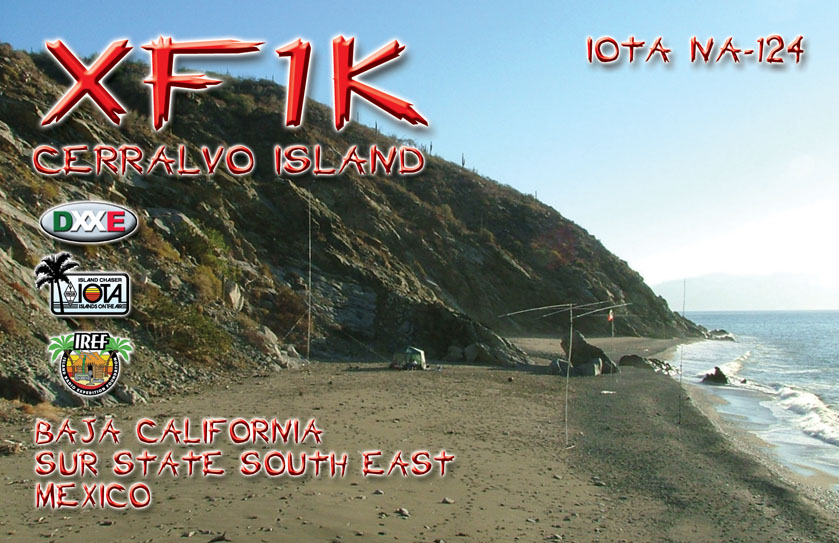
The XF1K team would like to thank Ing. Moises Ramirez (COFETEL) for his assistance with the licensing. We would also like to thank the Island Radio Expedition Foundation (IREF) for their support as well as the many amateurs who made donations for this trip: 7K3EOP, AA5AT, AA7AV, AB6QM, AD5A, JA1EY, JA1BPA, JA1SKE, JE1DXC, JG1OWV, JG1UKW, JA2AYP/1, JE2QYZ, JA3BKP, JA3UCO, JE3GUG, JI3MJK, JL3CRS, JA4UQY, JH4FRP, JF4VZT, JA5IU, JI5RPT/7, JN6RZM, JA7BWT, JA7DHJ/1, JE7JIS, JN7VUJ, JA8MS, JA9IFF, JR0DLU/1, K1HT, K3FN, K6DT, K8NA, K8SIX, K9AJ, KB5RHD, KD6WW, N5ET, N5UR, N6AWD, N6IC, N6KZ, N6PYN, N6VS, VE7QCR, VE7YL, W0BBT, W4DKS, W5BOS, W5BXX, W5PF, W6ED, W6UC, W6YOO, WA5VGI, WB2YQH, WF1N, XE1KK and XE2WWW. N6AWD and JN6RZM organized this fund raising. QSLs will be printed soon, so please send your cards to N6AWD. We were trying to work everyone who needed NA-124 and hope we were successful.
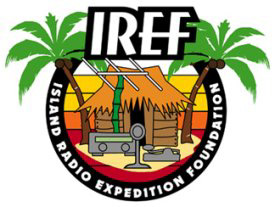
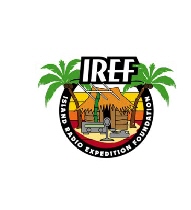
Isla Larga
Mexico
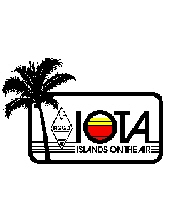 Here is a little about the XE2K/XF2 and XE2WWW/XF2 trip to Isla Larga. This was trip that was necessary to make sure the island even counted before a full scale operation could take place. There are no qualifying island in the directory for this group. However google earth suggested that there were islands that do count. So after discussing with Roger G3KMA Hecter XE2K, Jorge XE2WWW and myself Mike AB5EB decided to make a trip for this purpose. The evening before our short operation we drove from XE2WWW qth in Reynosa Mexico to the gulf. This is just under two hours from Jorge's house. By the way I should comment that Jorge was a superb host to both Hector and I and we both enjoyed our stay with him and his family. After talking to a boat captain who went by the name "Manteca" (those who know spanish should find this funny) and taking a boat ride to look at the island we thought we would try for a short operation and to furhter scout out the island, so we were to meet Manteca between 7am and 8am for the ride out. The next morning we were meet by Manteca's trusty side kick Jose who took us to the island. He initially tried to take us to the wrong island and almost ran over a wood pole sticking about 10 feet out of the water at 30 mph. Needless to say we were all a little worried about our captain. He said he had drank too much the night before, this didnt make us feel any better. We were able to get the boat within about 150 feet of the beach and waded in with the equipment. We set the station up in about 30 mintues and Jorge started on CW on 40m for the W5's. Jorge is new to IOTA but is very eager to become much more active in all things that include DX. All in all we found the site to be very conducive to a major operation later in the year. We have enough room that we may even try some big low band antennas since this winter should be one of the best for the low bands. We made just under 450 contacts in about 4 hours of operations. For those that did not make it in the log I am sorry but stay tuned we will return soon. The expedition was not funded in anyway by IREF. Below are a few pictures from the trip. QSL via N6AWD Mike AB5EB
Here is a little about the XE2K/XF2 and XE2WWW/XF2 trip to Isla Larga. This was trip that was necessary to make sure the island even counted before a full scale operation could take place. There are no qualifying island in the directory for this group. However google earth suggested that there were islands that do count. So after discussing with Roger G3KMA Hecter XE2K, Jorge XE2WWW and myself Mike AB5EB decided to make a trip for this purpose. The evening before our short operation we drove from XE2WWW qth in Reynosa Mexico to the gulf. This is just under two hours from Jorge's house. By the way I should comment that Jorge was a superb host to both Hector and I and we both enjoyed our stay with him and his family. After talking to a boat captain who went by the name "Manteca" (those who know spanish should find this funny) and taking a boat ride to look at the island we thought we would try for a short operation and to furhter scout out the island, so we were to meet Manteca between 7am and 8am for the ride out. The next morning we were meet by Manteca's trusty side kick Jose who took us to the island. He initially tried to take us to the wrong island and almost ran over a wood pole sticking about 10 feet out of the water at 30 mph. Needless to say we were all a little worried about our captain. He said he had drank too much the night before, this didnt make us feel any better. We were able to get the boat within about 150 feet of the beach and waded in with the equipment. We set the station up in about 30 mintues and Jorge started on CW on 40m for the W5's. Jorge is new to IOTA but is very eager to become much more active in all things that include DX. All in all we found the site to be very conducive to a major operation later in the year. We have enough room that we may even try some big low band antennas since this winter should be one of the best for the low bands. We made just under 450 contacts in about 4 hours of operations. For those that did not make it in the log I am sorry but stay tuned we will return soon. The expedition was not funded in anyway by IREF. Below are a few pictures from the trip. QSL via N6AWD Mike AB5EB
Hector, myself and Jorge
Landing on the island
Jorge running the 20m pileup
Hector on 20m with beam in background. Hector takes his pileups serious
Our oasis in the sun.
Jorge and I leaving the island
The Tamaulipas State Group of islands consists of several barrier islands in the Laguna Madre. One of the largest of the inner islands is Larga. This island was chosen because it is easy to land on and has no population. On July 30, 2006, Hector, XE2K, Jorge, XE2WWW and Mike, AB5EB, made an initial trip to Larga for a few hours and qualified it to count for NA-246 using XE2K/XF2 and XE2WWW/XF2. Planning started for a larger operation.
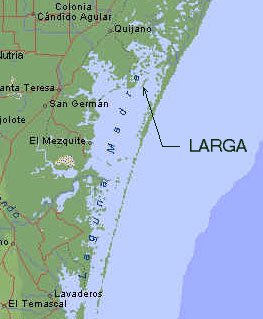
In early 2007, equipment was being assembled at the Reynosa, Tamaulipas QTH of Jorge. Several of the antennas and masts that have been used on XF1K operations were shipped across Mexico. The required paperwork for the operation was started to obtain the licenses for the special island operation and for the operators coming down from the United States. On the 22nd of February, the team assembled in Reynosa. Hector and Norm, N6JV, flew in from California where they were met by Jorge for the trip into Mexico. Marco, XE2S, was also picked up at the airport in Reynosa where he had flown in from Hermosillo, Sonora. Mike, AB5EB, drove to Reynosa from San Antonio, Texas. The rest of the day and evening were spent buying additional provisions and parts, assembling power cables and loading the trucks. On Friday morning, the two pickup trucks headed for the Gulf of Mexico and Laguna Madre which is about 130 km to the east. Foggy conditions resulted in a slower start to the operation.
This border area is closely controlled by the Mexican Navy. It is a prime area for smuggling. A courtesy visit was made at the Navy headquarters to explain who we were and where we would be. An unusual operation like this was sure to attract the attention of the Navy patrol boats. After the Navy’s approval, negotiations with Captain Jorge Mantecas were started and an agreement was made. He would provide two boats and several helpers to load and unload the boats. The gear was quickly loaded and the boats headed off to Larga.

Marco Jorge Mike Norm Hector
A landing area was found that was very close to a good camping spot. The boats were quickly unloaded. Norm slipped in the mud and did a back flip and landed on his back, but there was little damage. Hector and Marco started assembling the antennas while Mike and Norm put up the tents. Jorge would join the team the next day. The main tent was near the landing area and would have two of the transmitters. A second small tent would be located down the beach as far as the power cables would reach. This tent would have a single CW station. When the TH3jr tribander was up, a station in the small tent was ready and the initial contacts on 20 meter SSB were made with an ICOM 706 Mk II. K6QG and N6AWD, our QSL manager, were the first QSOs. An IC-756 PRO and AL811 amplifier were used on SSB and a TS-2000 was the second CW rig. Other antennas included an A3WS for the WARC bands, a DX88 vertical, an F12 vertical dipole and a 60 foot top loaded vertical for the low bands. Power was supplied by a single 5 KW generator.
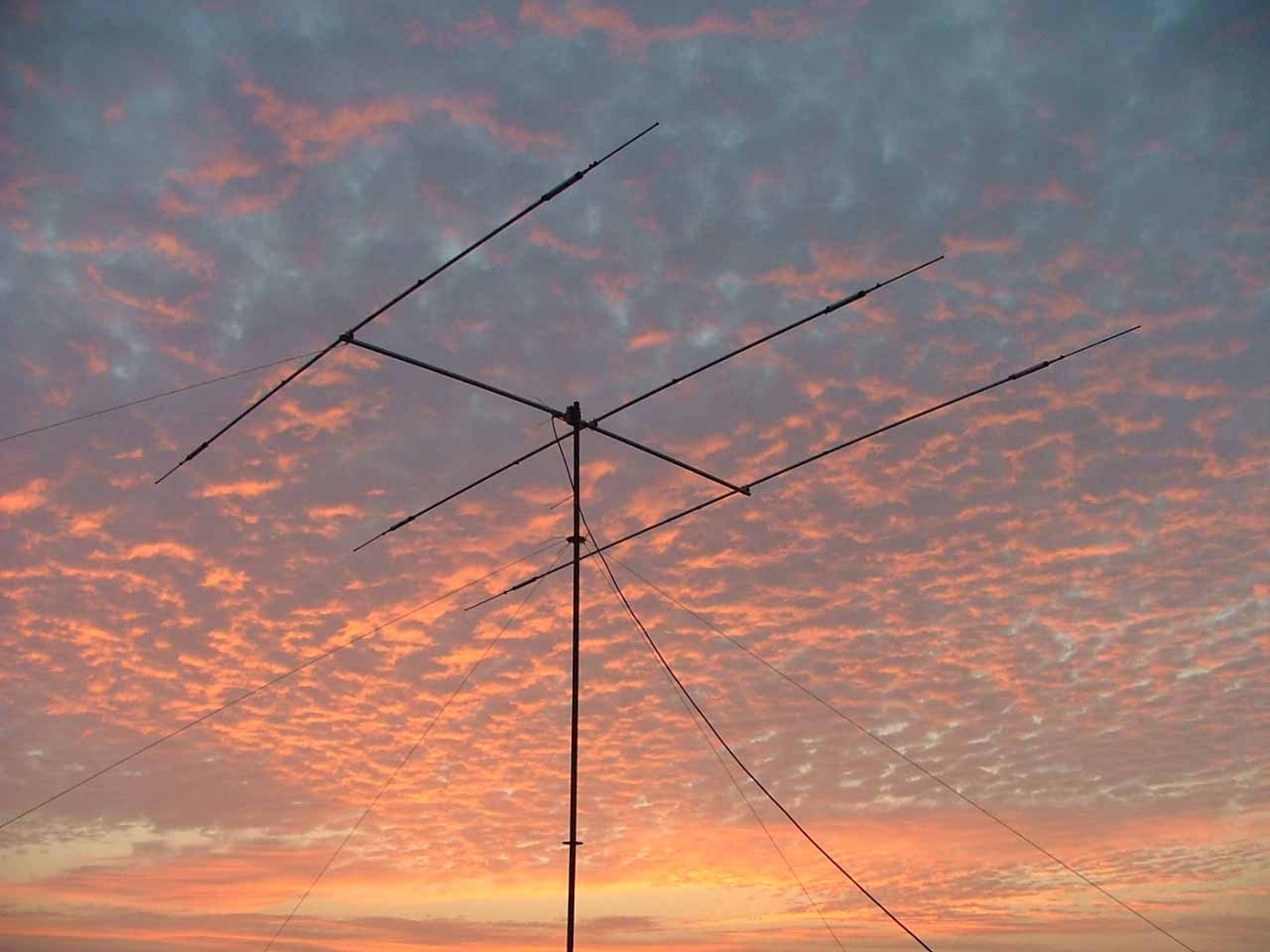
Conditions were very good on all bands except for 15 meters and above where conditions were very poor. All three stations were active on 17 and 20, SSB and CW until near dark when 30 CW, 40 CW and 75 SSB were started and run all night. Very large pileups of Europeans and Asian stations kept everyone busy day and night. By the end of the operation on Sunday morning, 7203 QSOs had been logged with 4002 on CW and 3201 on SSB. QSOs with Europe were 1726 and 952 were with Japan.
BAND SSB CW EUROS TOTAL (CW + SSB) 15 1 19 2 20 17 498 873 324 1371 20 1672 1240 701 2912 30 0 880 257 880 40 0 990 287 990 75 1030 0 155 1030
Captain Mantecas and his boats arrived back on Larga exactly as requested at noon on Sunday and they all assisted in taking down the tents and loading the boats. The sea was calm so the boats had a high speed race back to the mainland. With the trucks loaded, everyone returned to Reynosa for a barbeque dinner at Jorge’s home. Hector, Mike and Norm crossed the border and stayed near the Harlingen Airport so it would be easier to make flight schedules the next morning.
The XF2K team would like to thank Ing. Moises Ramirez and his associates (COFETEL) for their assistance with the licensing. We would also like to thank the Island Radio Expedition Foundation (IREF) for their support and to individual contributors JE1DXC and JM1PXG. Jorge and his wife were excellent hosts to all the operators at their home and provided invaluable assistance while dealing with many problems. All QSLs will be handled by our manager Fred, N6AWD. We wish to thank all who worked us and made this a very successful operation from NA-246.
This ends the official report.
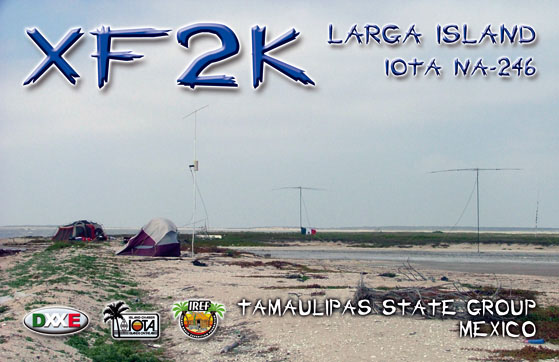
*************************************************************************************
This is the rest of the story. (Norm N6JV "Oidos de Piedra")
The weather was very good if you like high winds. The first night, both tents partially blew down in the early morning. The small tent was very light and a sun shade tarp had been wrapped around the windward side. This worked well until the second morning when a 50 mph wind came from the opposite direction and the tarp acted as a sail. It tried to lift the tent off the ground and put it in the sea with me in it. With the wind howling, I couldn’t yell for help and managed to get out and hang on to the tent supports while attempting to untie the tarp. After several exhausting minutes, the tent collapsed and wasn’t headed to sea. I went to the main tent for help, and Jorge and I tried to drive long posts into the sand to hold it down. Not much luck, so we woke up Hector and tried again. By this time, I was not feeling well and laid down in the dirt and was content to stay there. Jorge and Hector stabilized the tent and Jorge went to get Mike. As an ER doctor they decided they needed him as Norm was still laying in the dirt. Everyone knew of my medical problems and was very concerned. I managed to crawl into the tent and onto my bed where I was comfortable. I got some sleep until dawn. In the morning, I felt well enough to sit up, so made many QSOs on 20 CW until shutting down about 10 am. I was still not very steady and worked slowly. Eventually they made me sit down and not load anything else.
When we returned to the mainland, I was very tired and lay in the back seat of one of the trucks. Mike decided that they needed to get me across the border and get me checked out at a medical facility. After empting out the truck in Reynosa, Jorge and Mike drove to the border. At the border there was about a 30 minute wait, so Mike ran up to the Border Patrol people and explained that they had a sick American in the back of the truck. With a Border Patrol officer on the back of the truck, Jorge drove to the front of the line and into Texas. An ambulance was called and five ambulances responded. I don’t know which was chosen, but I was loaded in one of them and an IV and oxygen were started. They took me to the McAllen Heart Hospital while Jorge and Mike returned to Reynosa. Once in the emergency room they ran several tests on me and eventually decided that I was so dehydrated that my blood pressure would fall too low when I stood up. They started giving me fluids and poured 2500 ml of saline into my IV. About 10 pm they officially released me. Hector and Mike had loaded my gear and picked me up at the ER. We found a nice motel and we had some needed showers and a good nights sleep. I was especially careful to clean the blister I had gotten on my heel from walking around with wet feet and shoes the first day.
With flight delays, I didn’t make it home until 11:30 that night. As I was taking off my socks to go to bed, I noticed that my ankle was twice its regular size and the blister was very infected. My wife and I went to the local emergency room and they cleaned the blister and injected me with some painful antibiotic. By 3:30 am they had again released me with a prescription.
Lessons learned: When on an island operation, drink as much as you would at home and probably more. Try to have an ER doctor on your team and if he is a good CW operator, all the better. Remember what your mother told you about accidents, hospitals and clean underwear.

TAMAULIPAS STATE GROUP - NA-246
El 18 de Abril de 2008 fue el 83 aniversario de International Amateur Radio Union, IARU (www.iaru.org), y fue también el Día Mundial del Radioaficionado este año con el tema “Radioafición: una base de conocimiento técnico”. Grupo DXXE (www.dxxe.org) celebró la fecha con el indicativo especial XE-83-IARU: México en el 83 Aniversario de IARU.
April 18th 2008 was the International Amateur Radio Union´s, IARU (www.iaru.org) 83rd anniversary and it was also the World Amateur Radio Day this year with the theme “Amateur Radio: A Foundation of Technical Knowledge.” Grupo DXXE (www.dxxe.org) celebrated this date with the special callsing XE-83-IARU: Mexico on the 83rd Anniversary of IARU.
Ops: XE1AY Ismael, XE1BY Arturo, XE1CT Sergio, XE1CQ Hugo, XE1CWJ Javier, XE1GRR Rafael, XE1J Pepe, XE1KK Ramón, XE1MM Masa, XE1YYD Miguel Angel, XE1ZVO Alejandro, XE2HWB Bernardo, XE2K Hector, XE2WWW Jorge & XE2S Marco
Esta es una estación válida para el diploma DXXE: www.dxxe.org
This is a valid station for the DXXE award: www.dxxe.org
To celebrate 5 years of existence Grupo DXXE, Mexico’s top contest and DX radio club, will operate the special event callsign 4A1DXXE between December 20th to 31st 2009.
This will be an all band SSB, CW, RTTY and PSK31 operation.
Operators from this multi-location operation are:
Ismael XE1AY
Alex XE1EE
Tony XE1GRR
Pepe XE1J
Ramón XE1KK (Co-leader)
Carlos XE1MW
Joaquín XE1R (Co-leader & callsign trustee)
Miguel XE1YYD
Benjamín XE2AU
Bernardo XE2HWB
Héctor XE2K (Co-leader & schedule and log controls)
Marco XE2S
Jorge XE2WWW
Zalo XE3N
Daniel XE3RR
The QSL manager is Dick N7RO. Don´t send your QSL cards to the Mexican bureau since we will not have QSLs to answer. Make sure you bureau QSL card is clear marked via N7RO.
We will be frequently uploading the log to LoTW and we’re looking for completing electronically ARRL´s Triple Play Award and DXCC.
For log questions please contact Héctor, XE2K.
QSOs with this station are good for the DXXE Award. You don’t need to physically send the QSL cards to obtain it.
We would like to thank Ing. Patricia Huesca Baños and Don Samuel Guzmán from COFETEL for issuing this unique callsign.
Our 2008 operation with this same callsing made 15,580 QSOs with 118 DXCC entities so expect to hear us frequently and hopefully loud!
This is a good opportunity to confirm Mexico and Zone 6 on all band all modes.
Thanks for the call!